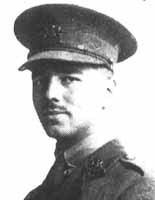|
"ANTHEM FOR DOOMED YOUTH" |
The redrafting of this poem with the help and encouragement of Siegfried Sassoon, whom Owen met while convalescing in Edinburgh’s Craiglockhart Hospital in August 1917, marked a turning point in Owen’s life as a poet. A remarkable writing period was just beginning. In sonnet form, ANTHEM FOR DOOMED YOUTH is an elegy, a lament for the dead, a judgement on Owen’s experience of war rather than an account of the experience itself. Doomed youth is right. These were young men, some very young.
Lines 1-8 (the octet) contain a catalogue of the sounds of war, the weapons of destruction – guns, rifles, shells – linked, ironically, to religious imagery, until in line 8 we switch from the fighting front to Britain’s "sad shires" where loved ones mourn. The tone now drops from bitter passion to rueful contemplation, the mood sombre, the pace slower, until by line 14 the poem quietly closes with "the drawing down of blinds".
In this octet the devilish clamour of trench warfare is carefully set against the subdued atmosphere of church. These religious images: passing bells, orisons (prayers), voice of mourning, choirs, candles, holy glimmers, symbolize the sanctity of life – and death – while suggesting also the inadequacy, the futility, even meaninglessness, of organized religion measured against such a cataclysm as war. To "patter out" is to intone mindlessly, an irrelevance. "Hasty orisons" are an irreverence. Prayers, bells, mockeries only. Despite Owen’s orthodox Christian upbringing, how his faith actually developed during the last years is far from clear, and it is hard not to think that he was not remembering in this poem those members of the clergy (and they were many) who were preaching not the gospel of peace but of war.
Right at the start the simile "die as cattle" jolts us with its image of the slaughterhouse and the idea of men being treated as less than human. "Anger of the guns" (line 2): were the men behind the guns angry? Probably not. Hatred of the enemy was more common among civilians than the troops. Onomatopoeia, alliteration and personification come together in line 3 in a brilliant sound image.
The juxtaposition of "choirs" and "wailing shells" is a startling metaphor, God’s world and the Devil’s both as one; after which line 8 leads into the sestet with the contrasted, muted sound of the Last Post.
Religious images and allusions dominate lines 9-14. Forget about altar boys and candle bearers, says Owen. These have nothing to do with the real rites. Look in their eyes and in the ashen faces of their womenfolk to learn the truth about war.
In line 12, "pallor" – "pall" (paleness - coffin cloth) is almost an example of Owen’s use of pararhyme (half rhyme), a poetic device which may give a downbeat, lowering effect or creates an impression of solemnity. "Flowers" (line 13) suggest beauty but also sadness, again a word that runs counter to the pandemonium of the first eight lines.
Aptly, dusk is falling in the last line and speaks of finality. The dusk is slow, for that is how time passes for those who mourn, and with the drawing down of blinds and the attendant sadness we may think of a house in Shrewsbury’s Monkmoor Road where at the eleventh hour - of the eleventh day - of the eleventh month - a telegram was delivered that informed Wilfred Owen’s parents of his death just a week earlier.
Anthem For Doomed Youth
(1917)Line 1 - What passing-bells for these who die as cattle?
Line 2 - Only the monstrous anger of the guns.
Line 3 - Only the stuttering rifles' rapid rattle
Line 4 - Can patter out their hasty orisons.Line 5 - No mockeries now for them; no prayers nor bells;
Line 6 - Nor any voice of mourning save the choirs,--
Line 7 - The shrill, demented choirs of wailing shells;
Line 8 - And bugles calling for them from sad shires.Line 9 - What candles may be held to speed them all?
Line 10 - Not in the hands of boys, but in their eyes
Line 11 - Shall shine the holy glimmers of good-byes.
Line 12 - The pallor of girls' brows shall be their pall;
Line 13 - Their flowers the tenderness of patient minds,
Line 14 - And each slow dusk a drawing-down of blinds.~ Wilfred Owen, 1893-1918
